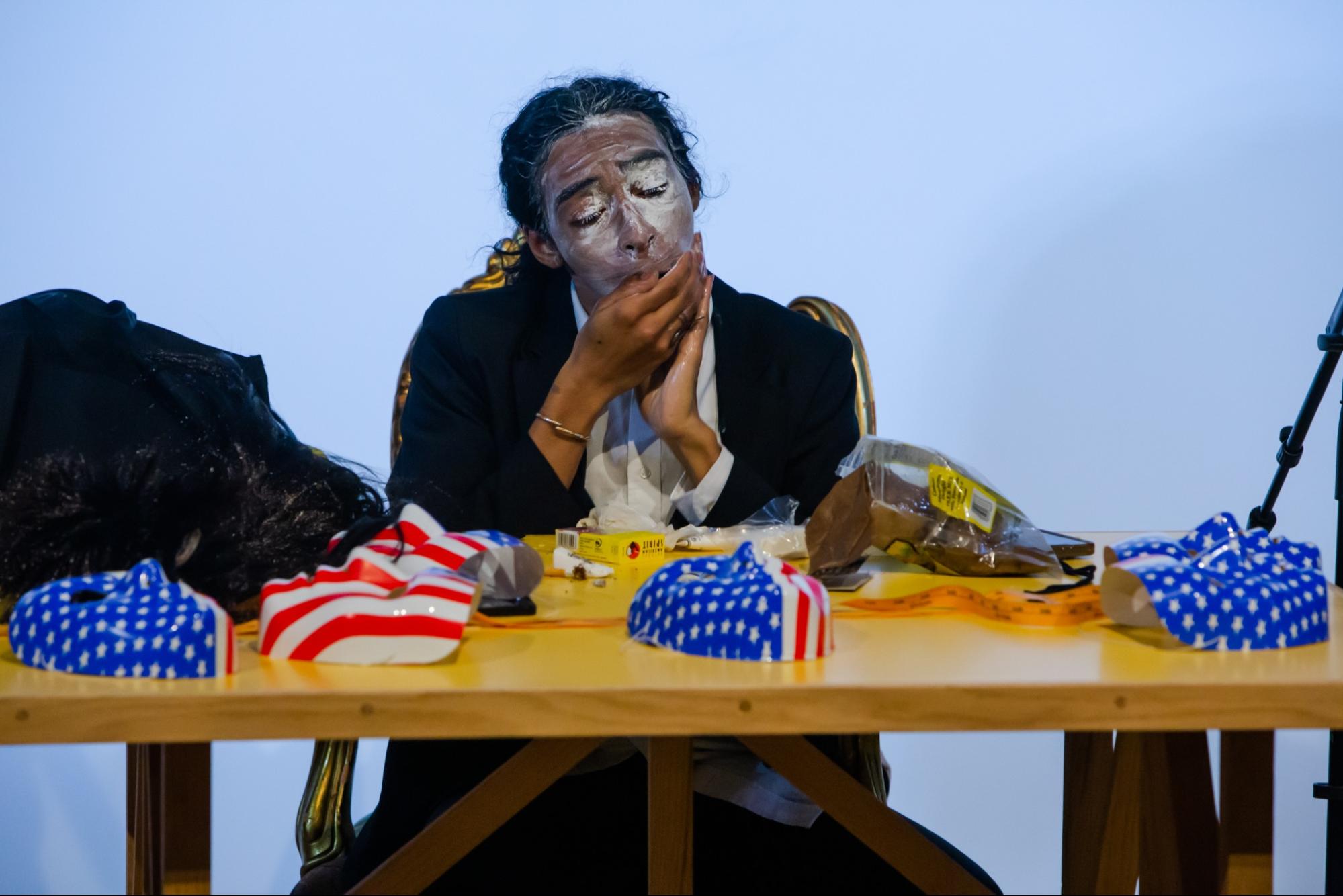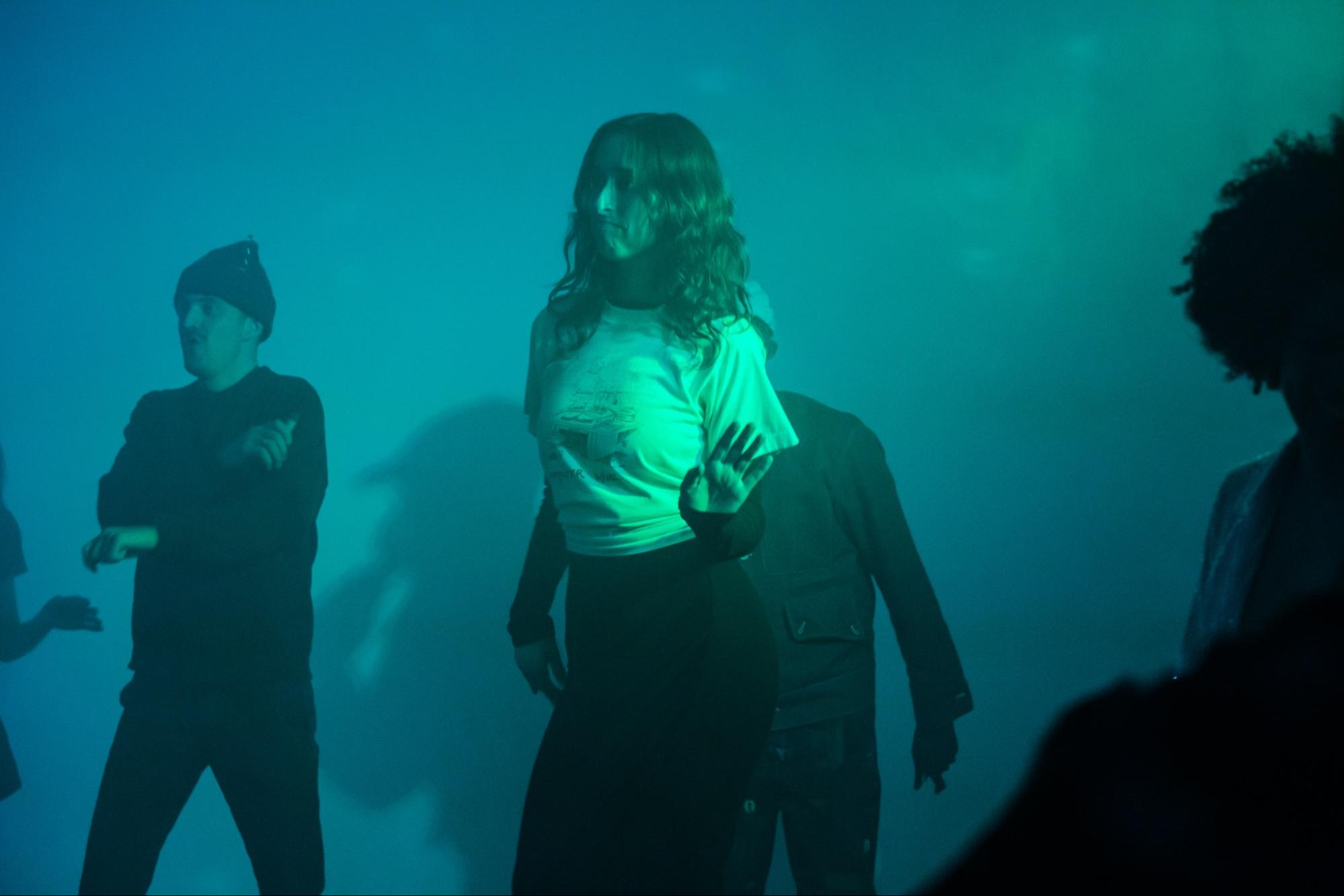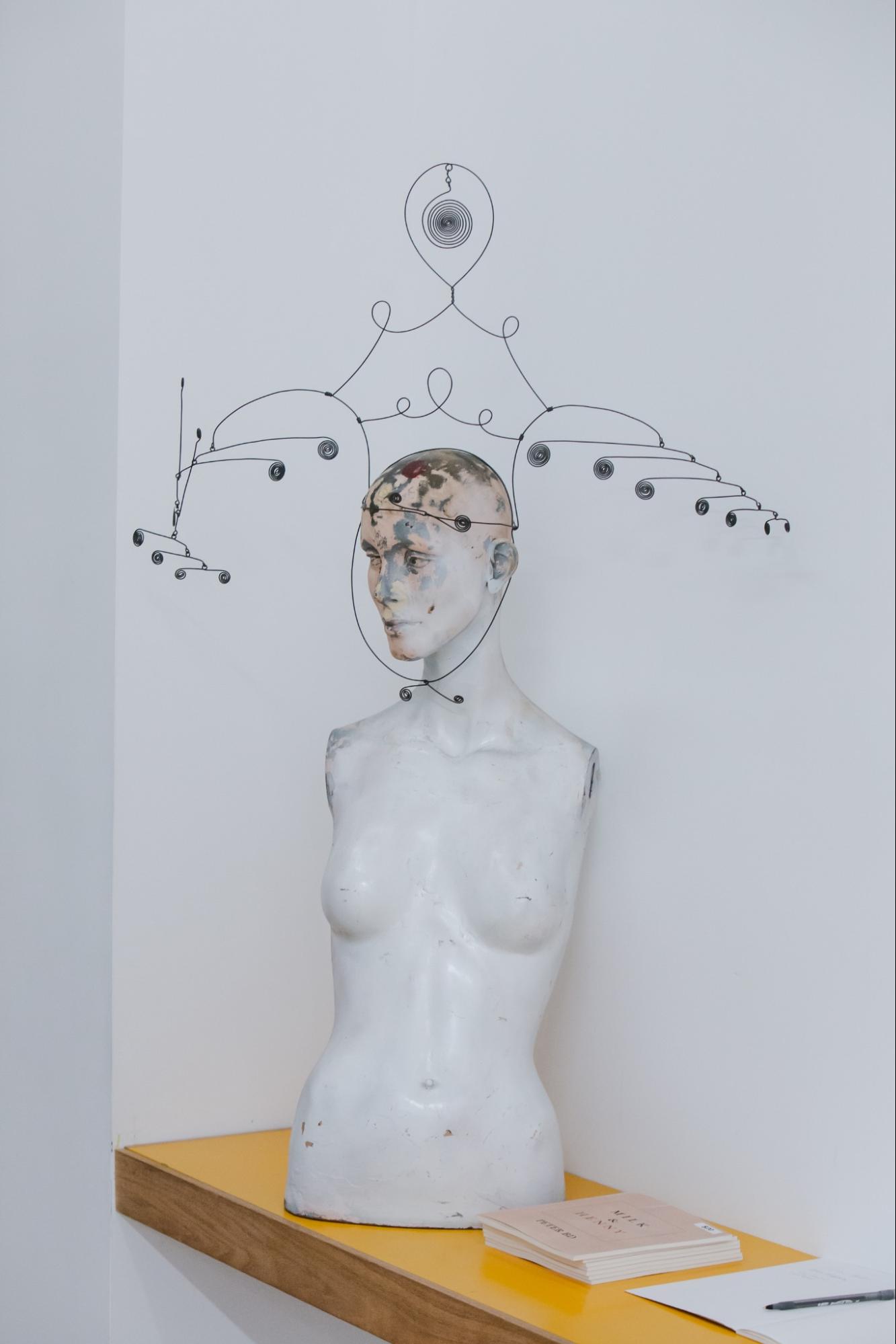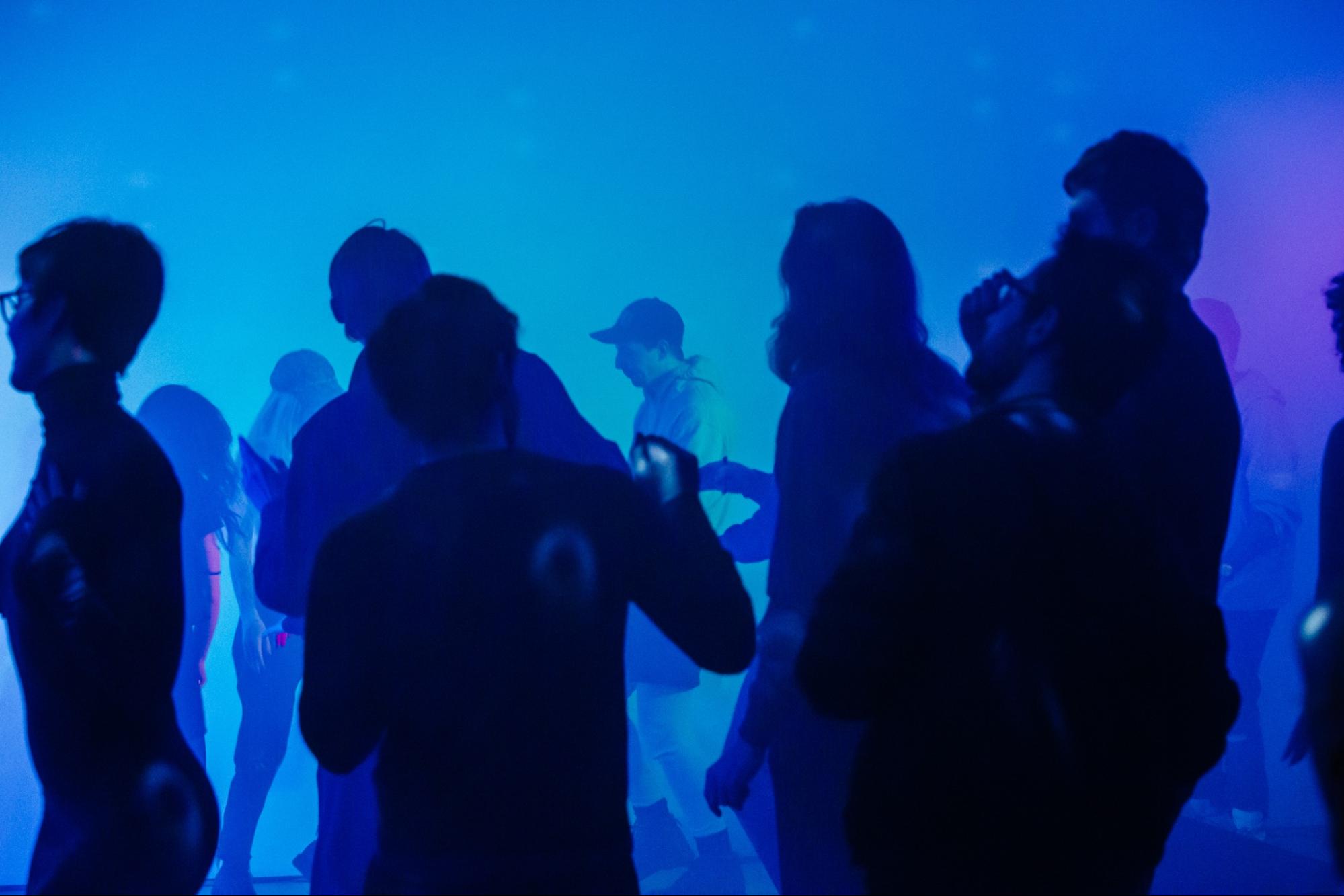DOWNTOWN
“This is All Make-Believe”: Meet Peter BD, The Phoneless Downtown Curator
An easy critique of the Downtown New York scene is that everyone postures as an artist but no one actually makes art. They’re wearing splattered denim but they don’t paint; they do drugs to inspire creativity but fall asleep to TV. You have to look in the right places to find those who can’t help but create—and the man central to one specific, experimental, ad-hoc cultural orbit is deliberately hard to reach. Without a phone or social media, poet Peter BD is mysterious but never snobbish. (Read his collection Milk & Henny to better understand; I like the one that goes, “you are nothing but a tiny dot in a universe filled with other tiny dots / culminating into a multitude of other dots. so many beautiful dots”.) Last week, his six-day curatorial residency at Canada Gallery in Tribeca proved that his most precious medium is other people. He cast Bobbi Salvör Menuez and Alex Tatarsky in a play about an art gallery; gave Dean Kissick, Ana Fabrega, and Diamond Stingily free reign on the mic; let Allison Brainard and ThugPop get weird for “erotica night.” In an era of contemporary art that trades on exposition of other-ed identity, Peter hacks the system to convince an institution to let him, his friends, and cooperative strangers play pretend in a big, white-walled space. Peter and I borrowed the gallerists’ office to chat during the eleventh hour before Connection opened. Between consultations with the lighting designer on the use of strobes and a stream of performers entering for rehearsal, we talked about finding space for “regular people” to make art.
———
GRETA RAINBOW: It’s the day before the opening of your show. How’s it going?
PETER BD: It’s intense but I’m used to it. The last time I saw you was when we ran into each other at Variety [Coffee, in Bushwick] and I had literally just moved the day before. Rich people bought my old building in Gowanus. All my stuff was in storage. For the last five months my life has been this show. I go to bed at three and wake up at seven and I feel fine because I think it’s like going to war, my body knows to get in action.
RAINBOW: The show is called “Connection” and I think that’s apt. For example, you met my best friend’s ex-boyfriend at my house last fall. They’ve since broken up but now he’s a big part of the show, and is dance partners with my other best friend in a piece on opening night.
BD: People have told me that they’re surprised when I actually follow through with asking them to make stuff together, not just to hang out at a bar. Trust that I’m going to.
RAINBOW: You pretty much force your friends to be artists.
BD: Yeah, that’s a really good thing, isn’t it? People are totally willing [to make art]. They want to. With this show I have big-name artists who have been doing it for a long time. And then I have Shira [Kindler, a law school student] as a dancer. Everybody gets to be an artist in their own way. You don’t have to be a fine artist. My friend Julia [Cooke], she’s a downtown girl, people just know her from around. She’s going to be vibing in the gallery–that’s the art piece. Her art piece is to exist!
RAINBOW: What’s attractive to you about this kind of art, which I guess you’d classify as performance?
BD: It’s much more than selling something. It’s more than the market. You literally can’t sell this show. You can buy some of the physical pieces. But even then, they represent each of the six days, which will only happen once. What do I really do that you can sell? I made [a series of short films] Milk & Henny In Quarantine but I still haven’t put it online because I wasn’t ready for it to be hyper-visible. I have my Kraine Theater show but it’s pay whatever you want. What I do isn’t transactional. “Hello, here it is, people creating things together.” I made this show up. I made it up for fun. I never even tried to monetize it. This is all make-believe. I don’t have anything to look to as an example and I don’t know what it’s going to look like until it happens.
RAINBOW: It’s a show where the medium is people and people are unpredictable.
BD: I have a hard time explaining the idea of “connection” beyond these people are just who I know. They’re all connected to me, and most of them are connected to each other and don’t even realize. We did a yearbook-style photoshoot of 40 people who are in the show and they’re all wearing wire spiral pieces. I do movie nights with my friend Max [Simon] and recently I saw these hanging things in his apartment. I’d never seen his art before. I’m like, “Yo, you should make some for me to wear to my show to obscure my face.” Then we needed something to metaphorically tie all the photos together, so he was sitting on the floor at the shoot making spirals. The photographer is Jamie [Ellington]; I met him in my friend’s bar. We started talking and I found out he shot for Calvin Klein. He said he’d help me out.
RAINBOW: I feel like you have this massive mental rolodex of creative people.
BD: It is mental because I don’t have a phone. I don’t have social media. So I have to think. I have to remember who I talked to and what we said we’d do. But it’s not hard because I love these people. Most of them were my friends before I knew what they did. Toya [Hariuchi] and I met at a party I go to and I knew him for a whole year before finding out he was an artist. Then one time I complimented his shoes, these really nice Converse loafers. He took them off and his name was inside the shoe–he did a design partnership with the brand that you could only get in Japan.
RAINBOW: How do you get all these busy people to say yes to you?
BD: I’m not forcing anyone! You know Precious Okoyomon, they do these big shows? We were roommates, broke as shit in Bushwick. They moved into my apartment from Ohio, really going through it. I feel like they remember that, so any time I call them and ask them to do something they say yes. They’re Zooming me from Paris asking what they should cook for the Day 4 dinner theater. It’s not this fake thing, it’s about getting to know the person first before it’s about trying to network. It’s, “I see you and you see me.”
RAINBOW: Why don’t you have a phone?
BD: It’s been so long [since I owned a phone]. I feel like I wouldn’t be doing what I’m doing now if I had a phone. I don’t know what I would do with a phone at this point. Even though it’s insane sometimes that I don’t have one.
RAINBOW: You make it work. You’re reliable. You’re reliably spending at least some of the party in a corner on the host’s laptop, signed into your Gmail to figure out your next move.
BD: It feels like I have a phone, right?!
RAINBOW: How do you keep up connections with people? That’s what prevents me from actually deleting Instagram beyond my current state of only using it on desktop browser–losing the DMs, worrying I’ll cease to exist in someone’s mind if I’m not following them.
BD: If you start up a connection you just don’t stop. I don’t go out that much. But I do keep in touch with people. You don’t have to talk all the time. I like to reach out and say, “Hey, what’s going on? Are you writing? Are you doing anything?” Suddenly years will have passed since I’ve known someone.
RAINBOW: You’re known for this cool kind of ritual: after you meet someone who makes an impression on you, you write them an email about them. It’s so different from the normative follow-up of adding each other on social media when you get home.
BD: Right, because I have to actually remember what they said to me. It’s fun for me to take whatever kooky story they told, about their Hawaiian grandma or being in jail when they were 19 or whatever, and say it back to them in a different way, hype them up a bit. I used to send those a lot so there’s a million of them. At the end of my shows I make everyone repeat after me: “I matter. I am important. I am beautiful. 2023 is going to be my year. I’m going to make so much money. I’m going to have a lot of sex.” Et cetera.
RAINBOW: And so few of these people know your full name or age or where you’re from. Why are you anonymous-ish?
BD: It wasn’t even a decision. It’s mostly because of the internet. I emailed two people I sort of knew, who might have known each other, and from there it became a thing to be the anonymous Peter BD. I was like “Huh?” But I leaned into it. Back then it was Tumblr, people had blogs, people had different avatars and aliases. A lot of the performers [in “Connection”] have aliases, actually, like Gabby Bess is now Goddess Earth. [During the blog era] we had different ways of interacting with each other and presenting ourselves. You would hang out on your little page or Tinychat. Now that it’s only Twitter and Instagram, everything seems more homogenous. Like, “How do we monetize people talking to each other?” We don’t have to do that.
RAINBOW: Are you uncomfortable being interviewed like this?
BD: I trust you. But it’s new, I’ve never done [a show] this way before. I’ve never been interviewed or aligned with some big institution. Usually, I’m pumping money into the work myself, doing my own tech. It’s always worked fine. I’ve never had someone give me $20,000 to make art.
RAINBOW: Do you want someone to give you $20,000?
BD: Who doesn’t want that? Imagine what I could do with it, because I can do a whole lot with a little. If we had real budget it would actually be kind of scary. I mean, I’m still gonna do what I do. No one needs to give me $20,000 ’cause they know Peter’s gonna do it anyway. So we don’t wait. Maybe it’ll be shot on an iPhone and cost two dollars, but it’ll still be what it needs to be.
RAINBOW: Can anyone be an artist?
BD: Only if they want to. They have to be confident, like, This is what I do. This is my art. Then the art can be anything. The art can be mac ’n cheese.
RAINBOW: What is your art about?
BD: Being alive. Making art.
RAINBOW: I’m imagining the critique that this whole endeavor isn’t actually egalitarian, it’s you boosting your friends, thereby perpetuating an insider-y culture that the “art world” is often criticized for.
BD: I’m just a regular person. These are just random ass fucking people. People on the street. People who don’t have websites. It’s never a clique and it can’t be, because I’m always adding new people to it. This show was curated by running into people in the city and figuring out what day they should be on. Or finding out what they want to do. I thought Emma [Olson] a.k.a. Umfang could DJ and she was like, “No, I want to do sound design.” Okay, great. I want everyone to showcase what they want to.
RAINBOW: Is it still possible to live in New York as an artist?
BD: Like, no. But we do. Also, I don’t even think of myself as an “artist in New York.” Do I come off like that?
RAINBOW: No. But your show program does have words like “aesthetic relations.”
BD: This is serious art, Greta. [He widens his eyes comically.] You know, I worked in an art gallery years ago. I’ve had so many jobs, that’s what a future book is going to be called, just “Jobs.” So it’s insane to me to be in an art gallery now because I’m here to do shit with my friends. I needed a space to do that in and found it. New York still has community, people pooling their money and resources.
RAINBOW: How do you understand community, a seriously misused word?
BD: I’m still trying to figure that out. It’s necessary, when you’re being creative, for it to not just be you. This could’ve been “the Peter show.” New short film, new book coming out. But no. At my last show Arjun [Srivatsa] said, “Any time Peter does something, he brings all his friends with him.” Any time the door’s open for me, I keep it open. Busting in like, “Come on guys, let’s go, let’s go!” Some people get the short end of the stick. That’s happened to me too. You don’t feel like you have opportunities. This show, if someone says they’re excited, I’m like, “Yeah, be excited, you’re a part of it.”
















